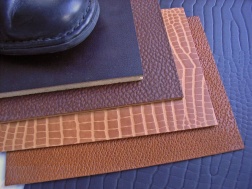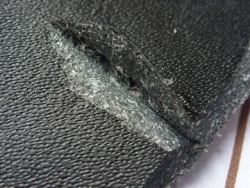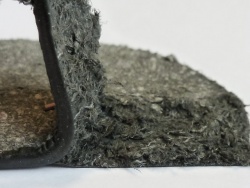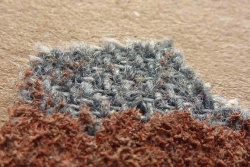Difference between revisions of "Bonded leather"
| Line 5: | Line 5: | ||
==Leather fibres== | ==Leather fibres== | ||
| − | + | When [[shaving]] leather in the [[leather production|tannery]], large amounts of leather fibres are produced. | |
==Bonded leather== | ==Bonded leather== | ||
| − | + | Bonded Leather (also called "reconstituted Leather") is a material consisting of leather fibres and binders. It's produced in roll ware. Bonded leather should at least have a leather fibre content of 50%. | |
| − | + | The leather-like properties of the material, its homogeneous structure, the favorable price and the processing as rollware material make leather fibres interesting. It is also positive, that it is produced from [[production waste of [[leather production]]. | |
| − | + | Bonded leather is produced in [[Thickness of leather|thicknesses]] of 0.25 to 6 millimetres. | |
| Line 21: | Line 21: | ||
</p> | </p> | ||
<p align=center> | <p align=center> | ||
| − | '' | + | ''Thick and firm bonded leather. - Bonded leather [[Leather floors -Leather tiles - Leather panels|flooring]] with [[Embossed leather|embossing]].''<br></p> |
<p> </p> | <p> </p> | ||
| − | + | Bonded leather is mainly used as a material for heels, soles and other non-visible components of [[leather shoes|shoes]]. Other processors are the [[leather furniture|furniture industry]] and [[Leather book cover|bookbinding]] companies. Bonded leather is used as a book cover. Bonded leather is also used as [[Leather floors -Leather tiles - Leather panels|floor panels]] or [[Leather wallpaper|wall panels]]. In the furniture sector, leather fibres usually only appear in connection with low-cost qualities. | |
| − | + | However, such materials cannot be sold with the term "[[leather#What materials can be called leather?|genuine leather]]", even if genuine leather fibres are a component. | |
| − | + | ||
| − | + | ||
| − | + | ||
| − | + | ||
| Line 38: | Line 34: | ||
</p> | </p> | ||
<p align=center> | <p align=center> | ||
| − | '' | + | ''A film on an easily tearing fibre composite.''<br></p> |
<p> </p> | <p> </p> | ||
| − | + | The surface consists of a film with a [[Leather hair pores - Hair follicles|hair pore]] impression and the material below is a fibre structure of leather fibres, which are connected with a binder. The material can be teared with two fingers without great effort. The fibres do not have a strong bond as with real leather. The fibres "stick" only to each other and are not naturally fused together and do not have the [[leather quality|stability of leather]]. | |
| Line 49: | Line 45: | ||
The products sold under the name "recycled leather" or "recycling leather" are divided into two. On one hand, bonded leather products are offered, but also [[artificial leather with leather fibres on the reverse]] are offered with such terms. | The products sold under the name "recycled leather" or "recycling leather" are divided into two. On one hand, bonded leather products are offered, but also [[artificial leather with leather fibres on the reverse]] are offered with such terms. | ||
| − | In both cases: If the term is used without further description, it does not comply with the [[Leather#What materials can be called leather?| | + | In both cases: If the term is used without further description, it does not comply with the [[Leather#What materials can be called leather?|labelling requirements]] for leather. |
==Regenerated leather== | ==Regenerated leather== | ||
| − | In the online trade the term "regenerated leather" emerges more and more often. This term is used for leather | + | In the online trade the term "regenerated leather" emerges more and more often. This term is used for leather fibre materials in case of cheap upholstery, newspaper stands, bookcases and other accessories. If the term is used without further description, this term does not correspond to the [[Leather#What materials can be called leather?|labelling requirements for leather]]. |
==[[Artificial leather with leather fibres on the reverse]]== | ==[[Artificial leather with leather fibres on the reverse]]== | ||
| − | In the [[leather furniture|furniture sector]], [[imitation leather]] is also offered, where leather | + | In the [[leather furniture|furniture sector]], [[imitation leather]] is also offered, where leather fibres are glued to the back in order to suggest a similarity to leather in the advertising. However, it is an [[imitation leather|artificial leather]] without leather properties. |
Revision as of 11:35, 31 January 2017
Contents
Leather fibres
When shaving leather in the tannery, large amounts of leather fibres are produced.
Bonded leather
Bonded Leather (also called "reconstituted Leather") is a material consisting of leather fibres and binders. It's produced in roll ware. Bonded leather should at least have a leather fibre content of 50%.
The leather-like properties of the material, its homogeneous structure, the favorable price and the processing as rollware material make leather fibres interesting. It is also positive, that it is produced from [[production waste of leather production.
Bonded leather is produced in thicknesses of 0.25 to 6 millimetres.
Thick and firm bonded leather. - Bonded leather flooring with embossing.
Bonded leather is mainly used as a material for heels, soles and other non-visible components of shoes. Other processors are the furniture industry and bookbinding companies. Bonded leather is used as a book cover. Bonded leather is also used as floor panels or wall panels. In the furniture sector, leather fibres usually only appear in connection with low-cost qualities.
However, such materials cannot be sold with the term "genuine leather", even if genuine leather fibres are a component.
A film on an easily tearing fibre composite.
The surface consists of a film with a hair pore impression and the material below is a fibre structure of leather fibres, which are connected with a binder. The material can be teared with two fingers without great effort. The fibres do not have a strong bond as with real leather. The fibres "stick" only to each other and are not naturally fused together and do not have the stability of leather.
Recycled leather
In case of inexpensive offers, the description "recycled leather" appears. This sounds as if used leather objects are being processed to new products. This may be true for some accessories, but they are not sold as "recycled leather".
The products sold under the name "recycled leather" or "recycling leather" are divided into two. On one hand, bonded leather products are offered, but also artificial leather with leather fibres on the reverse are offered with such terms.
In both cases: If the term is used without further description, it does not comply with the labelling requirements for leather.
Regenerated leather
In the online trade the term "regenerated leather" emerges more and more often. This term is used for leather fibre materials in case of cheap upholstery, newspaper stands, bookcases and other accessories. If the term is used without further description, this term does not correspond to the labelling requirements for leather.
Artificial leather with leather fibres on the reverse
In the furniture sector, imitation leather is also offered, where leather fibres are glued to the back in order to suggest a similarity to leather in the advertising. However, it is an artificial leather without leather properties.
Artificial leather with leather fibres glued to the reverse.
Additional information
- What materials can be called leather?
- What is genuine leather
- Artificial leather with leather fibres on the reverse
- Imitation leather













 a kotori web solution
a kotori web solution